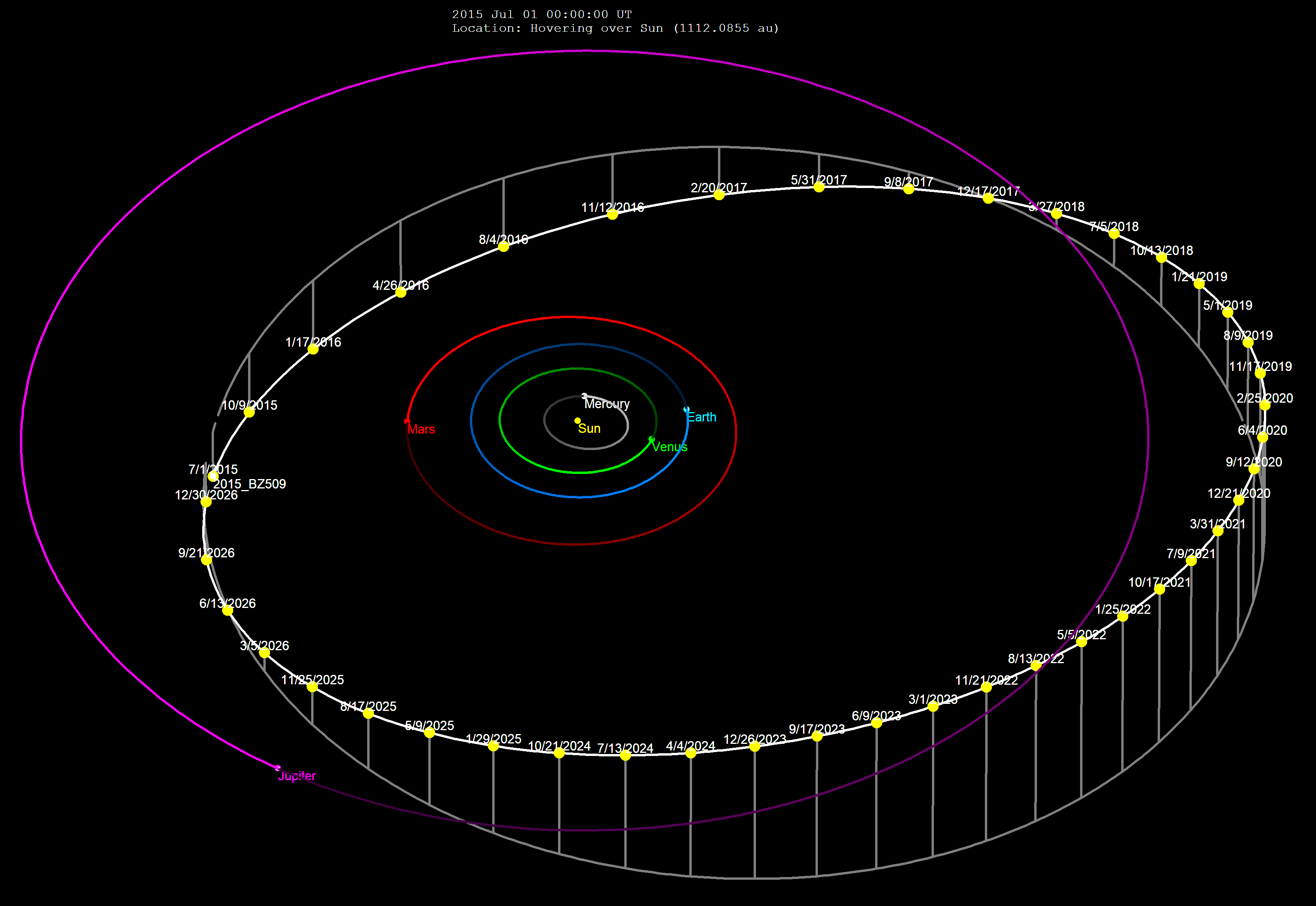Winston
Lorenzo von Matterhorn
- Joined
- Jan 31, 2009
- Messages
- 9,560
- Reaction score
- 1,748
This asteroid came from another solar systemand its here to stay
May 21, 2018
https://www.sciencemag.org/news/2018/05/asteroid-came-another-solar-system-and-it-s-here-stay
While astronomers around the world had their eyes fixed last year on Oumuamua, a lump of rock from another planetary system that whizzed through ours, little did they know that another interstellar interloper was quietly living among us. And this one appears to have been here for billions of years.
Astronomers first spotted the object, an asteroid called 2015 BZ509 that is orbiting close to Jupiter, in 2014. They knew it was unusual because it was traveling around the solar system in the opposite direction as almost everything else (its motion is shown in the animations above, with 2015 BZ509 circled). Astronomers have found other objects in retrograde orbits, perhaps knocked off course by passing too close to a giant planet, but 2015 BZ509s orbit was the weirdest of all because it is also elongated and out of alignment with the planets and other bodies.
To find out why, a pair of astronomers ran a series of 1 million simulations of the asteroids orbit, each with slightly different parameters. Jupiters orbit is a busy part of the solar system where the risk of being knocked off course is high, so eccentric orbits that are stable long term are unlikely. But the researchers found a number of possible orbits that were stable and concluded it is much more likely that 2015 BZ509 is in one of them, rather than that it happened to arrive for a short-term visit. Some of those stable orbits, if wound back in time, would mean that 2015 BZ509 has been with us since the beginning of our solar system, about 4.5 billion years ago.
There is no known mechanism that could have produced 2015 BZ509 in such an orbit when the planets were forming, the researchers report today in the Monthly Notices of the Royal Astronomical Society: Letters. Instead, the asteroid must have been drifting through space and was captured by the suns gravity.
Thats not as far-fetched as it seems. The sun and its planets formed inside a closely packed cluster of starswhich have since moved onand any object ejected from one planetary system by gravitational interaction could conceivably end up in another. The discovery of 2015 BZ509 quietly living in the solar system suggests we should look again at some other oddball asteroids; the teams simulations suggest that some of them may be interstellar interlopers as well. And if space agencies deemed it worth visiting one of them, we could find out if other planetary systems are made of the same stuff as ours.


May 21, 2018
https://www.sciencemag.org/news/2018/05/asteroid-came-another-solar-system-and-it-s-here-stay
While astronomers around the world had their eyes fixed last year on Oumuamua, a lump of rock from another planetary system that whizzed through ours, little did they know that another interstellar interloper was quietly living among us. And this one appears to have been here for billions of years.
Astronomers first spotted the object, an asteroid called 2015 BZ509 that is orbiting close to Jupiter, in 2014. They knew it was unusual because it was traveling around the solar system in the opposite direction as almost everything else (its motion is shown in the animations above, with 2015 BZ509 circled). Astronomers have found other objects in retrograde orbits, perhaps knocked off course by passing too close to a giant planet, but 2015 BZ509s orbit was the weirdest of all because it is also elongated and out of alignment with the planets and other bodies.
To find out why, a pair of astronomers ran a series of 1 million simulations of the asteroids orbit, each with slightly different parameters. Jupiters orbit is a busy part of the solar system where the risk of being knocked off course is high, so eccentric orbits that are stable long term are unlikely. But the researchers found a number of possible orbits that were stable and concluded it is much more likely that 2015 BZ509 is in one of them, rather than that it happened to arrive for a short-term visit. Some of those stable orbits, if wound back in time, would mean that 2015 BZ509 has been with us since the beginning of our solar system, about 4.5 billion years ago.
There is no known mechanism that could have produced 2015 BZ509 in such an orbit when the planets were forming, the researchers report today in the Monthly Notices of the Royal Astronomical Society: Letters. Instead, the asteroid must have been drifting through space and was captured by the suns gravity.
Thats not as far-fetched as it seems. The sun and its planets formed inside a closely packed cluster of starswhich have since moved onand any object ejected from one planetary system by gravitational interaction could conceivably end up in another. The discovery of 2015 BZ509 quietly living in the solar system suggests we should look again at some other oddball asteroids; the teams simulations suggest that some of them may be interstellar interlopers as well. And if space agencies deemed it worth visiting one of them, we could find out if other planetary systems are made of the same stuff as ours.





